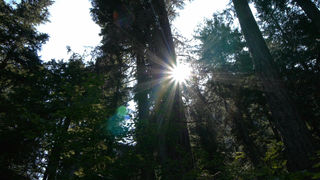Environment
Smart Trees Teach via New Film & Bestselling Book
What can people learn from trees? More than you think.
Posted October 5, 2016
Whose woods these are I think I know. ~ Robert Frost

Trees talk, know family ties and care for their young? Is this too fantastic to be true? German forester Peter Wohlleben ("The Hidden Life of Trees") and scientist Suzanne Simard (The University of British Columbia) have been observing and investigating the communication between trees over decades. And their findings are most astounding. ~ Dr. Julia Dordel, Producer Intelligent Trees
If the themes of harmony, connection, and collaboration between humans and trees in the movie Avatar inspired you, stand by. That fiction was inspired in part by real life trees… And scientists, as it turns out. But there’s more. Much more. And it has global implications for us all.

For starters, trees on opposite sides of the world—in their way—touched particular human beings, teaching them that trees do, in fact, communicate with and care for each other. In ways far more like Avatar’s depiction of forests’ “neural networks” than as individual trees standing alone in the woods.
Back in 2010, filmmaker Dr. Julia Dordel made a short film called Do Trees Communicate, she said in an email interview. That short film documented the revolutionary scientific findings of Dr. Suzanne Simard and her team at the University of British Columbia in Vancouver, Canada. Throughout the 1990s, Simard and her crew had been listening in on tree communication via root networks. They showed that Douglas fir and paper birch trees send each nutrients in times of need via their connected roots. They use fungus to do it.

Further, they showed that the oldest and largest trees in a forest – the so called “Mother Trees” – are central hubs that connect all surrounding trees, almost like a neural network.
Meanwhile, on the other side of the planet, Peter Wohlleben, a German forester entrusted with caring for a patch of woods in his forest district of the German Eifel was making remarkably similar observations, via different trees altogether. His insights, life, and observations inspired him to write what in Germany became an overnight bestselling surprise: Das Geheime Leben der Baeume. In English, The Hidden Life of Trees (Greystone Books), released in North America on Sept 13, 2016, and debuted on Oct 2 on the NYTs best sellers list at #5. (Check out Mothering Nature's interview with Wohlleben in conjunction with his book's North American release. And the New York Times spotlight that went viral: German Forest Ranger Finds Trees Have Social Networks, Too.)
As Wohlleben was writing and publishing his book Dordel says she continued to track Simard’s research. Simard’s science kept revealing that tree communication is far beyond what most people thought possible—that, in fact, a paradigm shift is happening. And it’s all because of what the trees are saying. And how they are saying it (For more, see Simard’s recent interview at Yale Environment 360: Exploring How and Why Trees ‘Talk’ To Each Other and her viral TED talk How Trees Talk to Each Other.)

Dordel says Simard’s research indicates “that trees even recognize and prefer their own kin over others of the same species (or other species). It also appears that tree-alarm-system is not only temporary but trees can remember threats and have something similar to a collective memory.”
Clearly, something big is afoot in the forest. And it’s not Sasquatch. But it is something mysterious, exciting, and potentially unifying for people around the world. Imagine the cultural shifts ahead when people deeply understand the true nature of interconnected living systems. Systems far more unified, communicative, and interwoven than our culture has so far admitted, or acted upon (as evidenced by climate change, soil erosion, ocean acidification, species extinction, and what we now call the Anthropocene: the age of human impact. Jeremy Rifkin illuminates this potential shift in our global psychology in his book The Empathic Civilization.).
In fact, Dordel was so inspired by Simard’s ongoing work that she teamed up with film director (Guido Töelke) to found Dorcon Films. Together they made another, more in-depth film depicting the astonishing science still being unearthed by Simard: Intelligent Trees. While in production, the filmmakers stumbled on Wohlleben’s book and saw global implications. They immediately brought him in alongside Simard in their new, just-released documentary.

Dordel said in the email interview that Intelligent Trees features the main observations covered in Wohlleben's book such as “the stump that has been kept alive by its neighboring trees, the old ‘tree-couple’ that looks after each other, the Mother Trees that suckle their offspring, etc... Special about this film is that it goes beyond observations and claims, and matches them with the latest underlying Forest Science Research – conducted by Simard and her team."
The film specifically looks at:

- Can Trees Talk to each other and care for one another? Wohlleben and Simard introduce the basic concept of tree communication and the role of Mother Trees.
- Under Attack - Can Trees be scared? The researchers discuss messages that are fired off, once a tree is attacked and how it warns it's neighbors.
- Passing on the wand - do trees have a memory? There can be life after (supposed) death of a tree.
- Coexistence of people and forest. The duo talks about how - due to a lack of understanding of tree behavior and needs - the forest industry mistreats the forests and what we can do to do better.
What do you think? Will evidence of tree communication and interconnection help inspire people’s own connection to themselves, each other, and the natural world?
You can see the trailer for Intelligent Trees on Vimeo or at the Greystone Book's homepage for The Hidden Life of Trees. Intelligent Trees is also available in its entirety as Video on Demand Amazon and Vimeo. Or you can get the brand-new DVD.
*****
Rachel Clark's first book, The Blackfish Prophecy (Fawkes Press 2016, endorsed by Dr. Jane Goodall) is a novel about kids, killer whales, and the interconnection of all Life. Here is the Kirkus review. As a science writer who's covered the environment for nearly 20 years, she's fiercely hopeful about the psychological power of books, story, movies, and literature to help tilt the world towards Harmony. If you're an author, writer, or filmmaker interested in being featured on Mothering Nature, please contact Rachel via her PT contact page.




